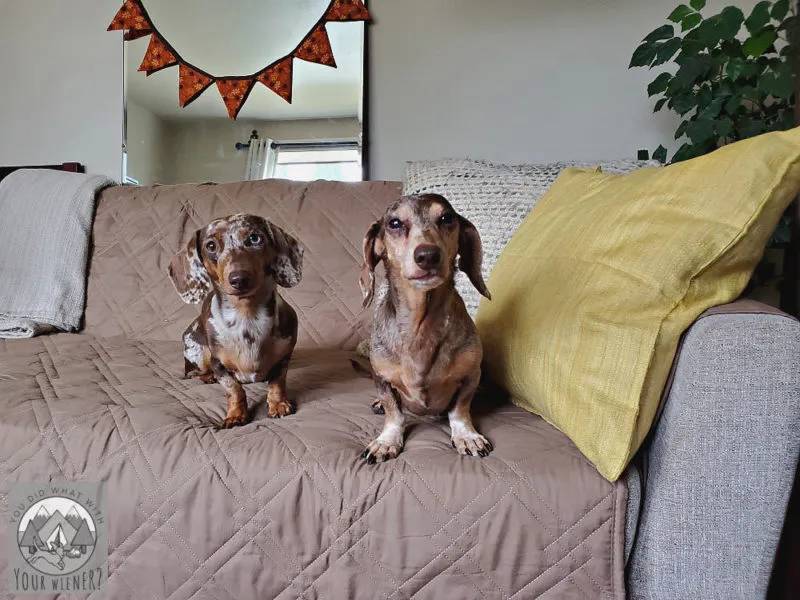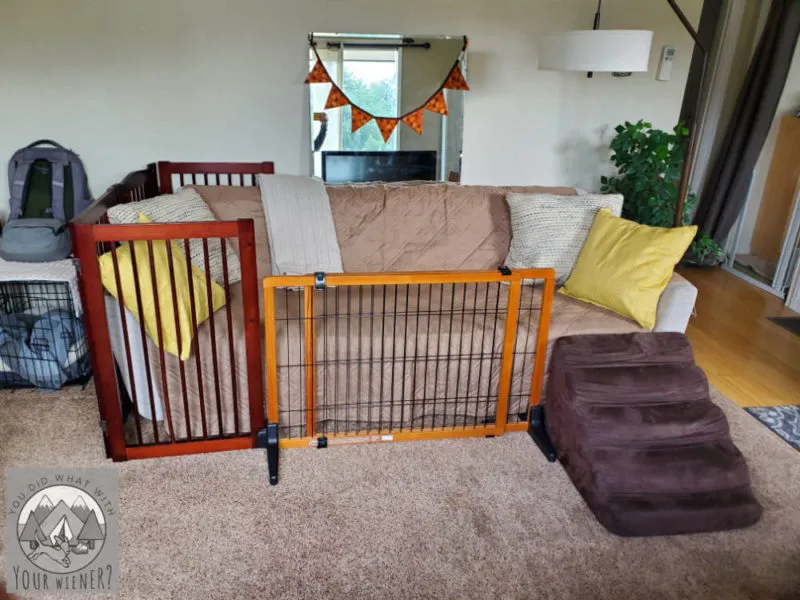For many dog owners, seeing their furry friend leap onto the couch is a common sight. While often endearing, this behavior can pose significant risks, especially for breeds prone to back injuries like Dachshunds, or simply become an unwanted habit. Successfully teaching your dog to stay off the couch, or to use it safely, requires a blend of consistent training and smart environmental management. This guide from Dog Care Story delves into practical strategies to Train Dog To Not Jump On Couch, ensuring both their safety and your peace of mind.
Understanding Why Dogs Jump on the Couch and Its Risks
Dogs jump on the couch for a variety of reasons: seeking comfort, attention, proximity to their owners, or simply because it’s a high vantage point. While seemingly harmless, repeated jumping on and off furniture can lead to serious health issues. For breeds like Dachshunds, with their long backs and short legs, Intervertebral Disc Disease (IVDD) is a constant concern. A single awkward jump can lead to a slipped disc, resulting in pain, paralysis, and costly veterinary care. Even for sturdier breeds, joint strain and injuries can occur over time. Therefore, establishing clear boundaries and safe habits regarding furniture is a crucial aspect of responsible dog ownership. Just as we focus on managing common puppy behavioral issues like barking, ensuring your dog understands safe furniture etiquette is vital for their long-term well-being.
The Dual Approach: Training and Environmental Management
Effective strategies to train your dog to not jump on the couch typically involve a two-pronged approach: positive reinforcement training combined with strategic environmental controls. Relying solely on training can be insufficient, particularly when dogs are excited, unsupervised, or revert to old habits. Environmental management creates physical barriers or alternative safe pathways, making the desired behavior the easiest and most consistent choice.
Training Your Dog to Stay Off the Couch (or Use a Ramp)
Positive reinforcement is the cornerstone of any successful dog training.
- The “Off” Command: Start by luring your dog off the couch with a treat. As they step down, say “Off” and immediately reward them. Practice this consistently. If they jump up without permission, calmly lead them off without scolding and then practice the “Off” command again. The goal is to make staying off the couch a rewarding experience.
- Rewarding Alternative Behaviors: Provide a comfortable, designated spot for your dog on the floor – a cozy bed, a mat, or a blanket. When they choose this spot, lavish them with praise and treats. This teaches them that their own bed is a highly desirable place to be.
- Introducing a Ramp or Stairs: If you want your dog to access the couch safely, introduce a ramp or stairs. Lure them onto and off the ramp with high-value treats, praising every step. Practice multiple times a day until they use it confidently. This is especially vital for breeds susceptible to back issues.
- The “Wait” Command: A “Wait” command can be incredibly useful. Teach your dog to stay put until released. This allows you to position yourself to help them off the couch or ensure they use the ramp, even in situations where gates aren’t possible. Consistency is key across all aspects of training, from mastering the “wait” command to effective leash training techniques.
Implementing Environmental Controls for Safety
Even with thorough training, physical barriers often provide the most reliable protection.
- Gating Off the Couch: This is perhaps the most foolproof method. By strategically placing pet gates around the couch, you create a controlled access point, forcing your dog to use a ramp or preventing them from accessing the couch entirely.
- Using Physical Deterrents: For temporary solutions or when you’re not home, place items on the couch that make it less appealing to jump on, such as laundry baskets, upside-down chairs, or specialized “couch defenders.”
- Managing Room Access: If the couch jumping is a significant concern, consider restricting your dog’s access to the room where the couch is located when you cannot supervise them. Use baby gates at doorways or simply close doors.
- Adjusting Other Furniture: Don’t forget other furniture. Lowering your bed, turning office chairs to face a wall, or pushing dining chairs fully under tables can prevent unwanted jumping and potential injuries. Just as managing a dog’s environment is crucial for preventing couch jumping, similar strategies are vital for challenges like getting your dog to stop pulling on walks, where environmental factors and consistent guidance play a huge role.
Our Personal System: A Case Study in Preventing Couch Jumping
Our experience with Gretel, our Dachshund, underscores the necessity of a robust system. After Gretel was diagnosed with IVDD, preventing her from jumping off the couch became a critical priority. We initially considered two main options: completely blocking couch access or ensuring the only way on and off was via a ramp. Given how much our Dachshunds love cuddling on the couch, we chose the latter.
 Dachshunds comfortably resting on a brown sofa, illustrating a common household scenario.
Dachshunds comfortably resting on a brown sofa, illustrating a common household scenario.
Our system involves strategically placing the couch against a wall and completely gating off the open sides. This setup, complemented by a sturdy dog ramp, ensures that the ramp is the only viable path for our dogs to ascend or descend.
 A practical setup demonstrating dog gates and a ramp surrounding a couch, designed to train a dog to use the ramp instead of jumping.
A practical setup demonstrating dog gates and a ramp surrounding a couch, designed to train a dog to use the ramp instead of jumping.
We did train dog to not jump on couch and to use the ramp, but relying solely on training proved insufficient. Even with consistent training, moments of over-excitement or distraction led to spontaneous jumps, one of which resulted in Gretel’s first back injury. This experience solidified our commitment to the gate system as an indispensable safety measure. While dogs generally prefer the path of least resistance, occasional urges to jump require physical safeguards. We also place pillows strategically to create an additional barrier, guiding them towards the ramp.
This setup, while not ideal for human convenience, is a small trade-off for our dogs’ safety. The inconvenience of fences around the couch is far less significant than the potential for another debilitating back injury. This comprehensive approach reflects our broader commitment to ensuring a safe home environment for our pets, including specific training like how to stop your dog from pulling on his leash, where consistent boundaries and tools are equally important.
For other furniture, we’ve made similar adjustments. Our bed height was lowered by placing the mattress and box spring directly on the floor. Office chairs are turned to face walls when not in use. Dining chairs are always pushed in or blocked to prevent access. Our entire home is essentially arranged with our dogs’ well-being as the primary consideration.
Alternatives to Our Couch Blocking Strategy
While our gated system works for us, it’s essential to assess your own situation and comfort level. You don’t have to block off your couch in the same way. However, if you want absolute assurance that your dog won’t jump off the couch, particularly when unsupervised or highly energetic, then keeping them off the couch entirely is the most reliable alternative.
You can prevent your dog from accessing the couch by:
- Restricting room access: Close the door to the room or use a pet gate at the entrance.
- Making the couch unappealing: Place physical deterrents on the couch seat, like spiky mats, laundry baskets, or specialized products such as a Couch Defender.
If your dog loves the comfort of the couch, like many Dachshunds enjoy burrowing under blankets, ensure you provide equally appealing alternatives. A super soft, cozy dog bed in the same room can make their own spot more desirable than the couch, reinforcing the training to stay off furniture. This balance of prevention and offering positive alternatives is key for various behavioral challenges, including how to stop dog from pulling on leash while walking, where redirecting energy to desired actions is critical.
Conclusion
Successfully training your dog to not jump on the couch is a continuous effort that combines effective behavioral training with thoughtful environmental management. Whether you opt for a comprehensive gate system, consistent “off” commands, or a combination of approaches, the primary goal remains your dog’s safety and well-being. By understanding the risks, implementing appropriate training, and making necessary adjustments to your home, you can protect your beloved companion from potential injuries while fostering good habits. Always prioritize their health, and don’t hesitate to consult with your veterinarian or a professional dog trainer for personalized advice.
